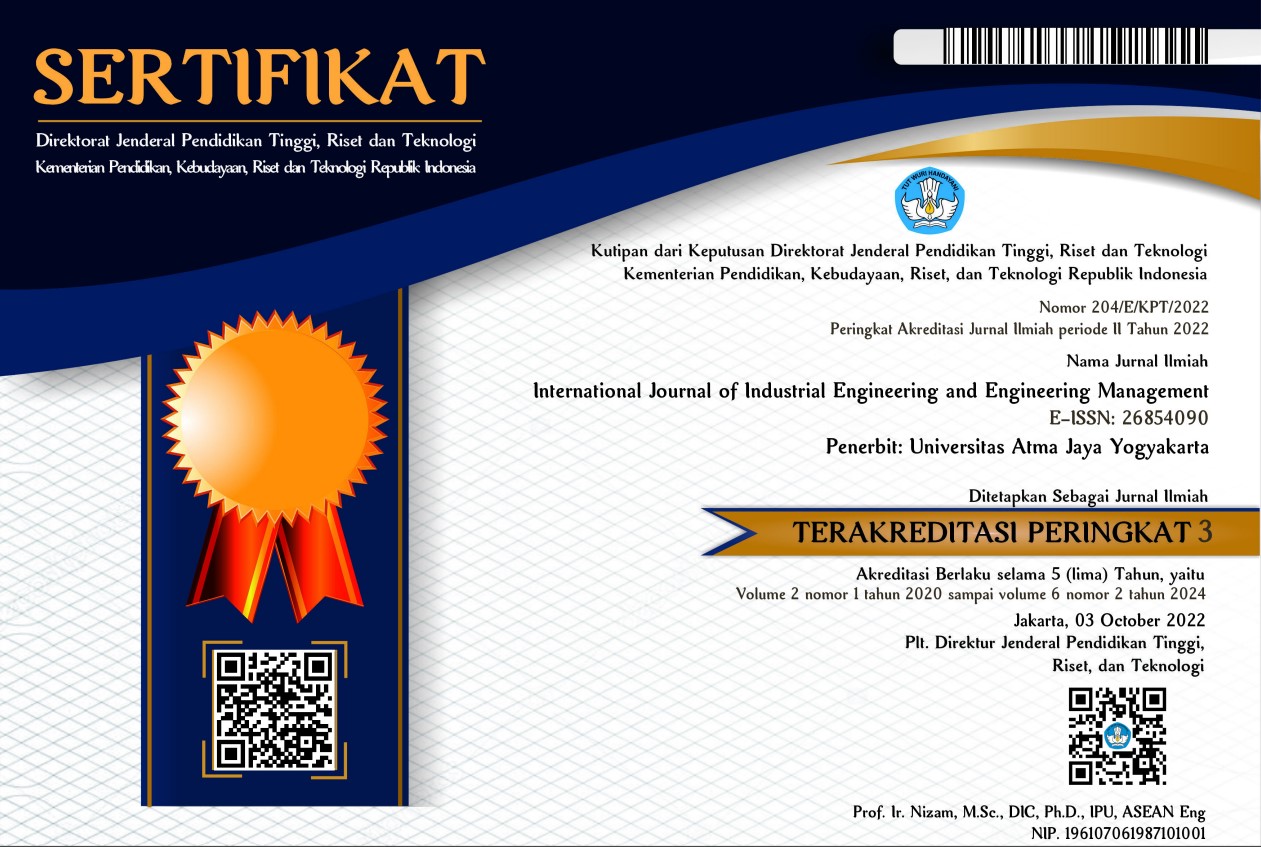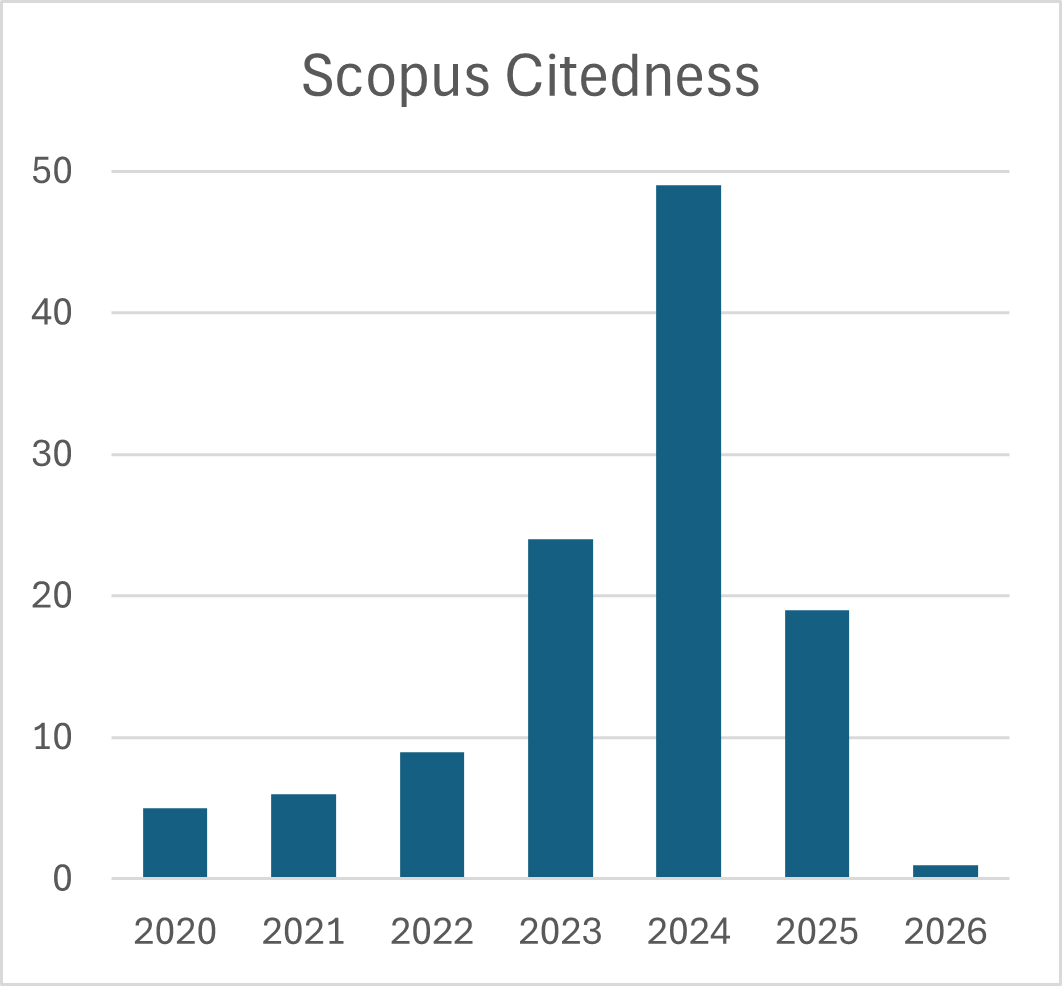Optimization of Process Parameter of Tungsten Inert Gas Welding for Austenitic Stainless Steel using Grey Wolf Optimization
DOI:
https://doi.org/10.24002/ijieem.v4i2.5748Keywords:
Tungsten inert gas, optimization, austenitic stainless steel, ultimate tensile strength, yield strengthAbstract
Optimization of welding parameters is essential on austenitic stainless steel for industrial applications since they declare the best parameters compared with prioritized constraints. However, available optimization methods, such as the Taguchi method, widely used in this research domain, are weak. Their results are merely comparative and fail to particularly show the specific factor that displays the highest performance in the process. In this paper, the aim is specifically to position the parameters in order of importance and present them in a grey wolf optimization framework. The ultimate tensile strength and yield strength were optimized, and the optimization was conducted using the C++ programming code. Literature data were analyzed for austenitic stainless steel under un-notched/smooth and notched specimen conditions. Empirical models were developed for the ultimate tensile strength and yield strength, among other principal criteria of the material. For the ultimate tensile strength, the best value was obtained at the 100th iteration as 640.75. For the yield strength, the best value of 394.98 was obtained after 100 iterations. A value of 31.07 for the PE was obtained. These results are for the unnotched specimens. However, the PE, NTS, and yield strength values for the notched specimens are 16.32, 780.12, and 494.46, respectively. Based on the findings of this study and compared with other optimization methods, the optimal parameters and outputs predicted using the grey wolf optimization approach were found to produce reliable results. This shows that the grey wolf optimization approach is a good option for predicting the optimal parameters of the tungsten arc welding process by utilizing austenitic stainless steel. The usefulness of this research effort is to help process engineers to implement robust and effective cost decisions in the production of materials based on austenitic stainless steel.
References
Abdallah, A. (2014). Optimization of cutting parameters for surface roughness in CNC turning machining with aluminum alloy 6061 material. IOSR Journal of Engineering, 4(10), 220-302.
Abdulkaree, S., Khan, A., & Zain, Z. (2011). Effect of machining parameters on surface roughness during wet and DryWire-EDM of stainless steel. Journal of Applied Sciences, 11(10), 1867-1871.
Abhang, L.B., & Hameedullah, M. (2012). Optimization of machining parameters in steel turning operation by Taguchi method. Procedia Engineering, 38(1), 40-48.
Ahmed, Y.S., Fox-Rabinovich, G., Paiva, J.M., Wagg, T., & Veldhuis, S.C. (2017). Effect of built-up edge formation during stable state of wear in AISI 304 stainless steel on machining performance and surface integrity of the machined part. Materials, 10(11), Article 1230.
Ahmed, K.H., Abdul, L., Mohd, J., & Pramesh, T. (2010). Influence of welding speed on tensile strength of welded joint in TIG welding process. International Journal of Applied Engineering Research, 1, 518-527.
Bodkhe, S.C., & Dolas, D.R. (2018). Optimization of activated tungsten inert gas welding of 304L austenitic stainless steel. Procedia Manufacturing, 20, 277-282.
Chakraborty, S., & Mitra, A. (2018). Parametric optimization of abrasive water-jet machining processes using grey wolf optimizer. Materials and Manufacturing Processes, 33(13), 1471-1482.
Chaudhari, A., Srivastava, A., Roy, T.K., Chakrabarti, A.K., & Dastur, M.N. (2017). Surface integrity, surface finish, and corrosion characteristics of stainless steels in saline water. International Journal of Advance Research and Innovation, 5(2), 264-267.
Chuaiphan, W., & Srijaroenpramong, L. (2020). Optimization of TIG welding parameter in dissimilar joints of low nickel stainless steel AISI 205 and 216. Journal of Manufacturing Processes, 58, 163-178.
Endrino, J.L., Fox-Rabinovich, G.S., & Gey, C. (2006). Hard AlTiN, AlCrN PVD coatings for machining of austenitic stainless steel. Surface and Coatings Technology, 200, 6840–6845.
Ezugwu, E.O., & Olajire, K.A. (2002). Evaluation of machining performance of martensitic stainless steel. Tribology Letters, 12, 183-187.
Ghosh, N., Pal, P.K., Nandi, G., & Rudrapati, R. (2018). Parametric optimisation of gas metal arc welding process by PCA based Taguchi method on austenitic stainless steel. AISI 316L. Materials Today: Proceedings, 5(1), 1620-1625.
Ghosh, N., Pal, P. K., & Nandi G. (2016). Parametric optimization of MIG welding on 316L austenitic stainless steel by grey-based Taguchi method. Procedia Technology, 25, 1038-1048.
Ipilakyaa, T.D., Gbashi, S.M., Omenka, I.K., Okwori, E.A., & Uche, R.B. (2019). Effect of cutting parameters on surface roughness of stainless steel during turning operation. Taraba Journal of Engineering and Technology, 1(2), 8-12.
Jegan, T.M.C., Anand, M.D., & Ravindran, D. (2012). Determination of electro-discharge machining parameters in AISI202 stainless steel using grey relational analysis. Procedia Engineering, 38, 4005-4012.
Karhu, M., & Kujanpää, V. (2022). Gas tungsten arc process optimization and assessment for robotized position welding of austenitic stainless steel edge joints. CIRP Journal of Manufacturing Science and Technology, 36, 12-22.
Kaladhar, M., Subbaiah, K.V., & Rao, C.S. (2011). Performance evaluation of coating materials and process parameters optimization for surface quality during turning of AISI 304 austenitic stainless steel. International Journal of Engineering, Science, and Technology, 3(4), 89-102.
Kharwar P.K., & Verma, R.K. (2021). Nature instigated Grey wolf algorithm for parametric optimization during machining (milling) of polymer nanocomposites. Journal of Thermoplastic Composite Materials.
Kirby, E.D., Zhang, Z., & Chen, J.C. (2004). Development of an accelerometer-based surface roughness prediction system in turning operation using multiple regression techniques. Journal of Industrial Technology, 20(4), 1-8.
Klocke, F., Döbbeler, B., Lung, S., Seelbach, T., & Jawahir, I. S. (2018). Analysis of surface integrity in machining of AISI 304 stainless steel under various cooling and cutting conditions. AIP Conference Proceedings, 1960(1), Article 070015.
Krolczyk, G., Gajek, M., & Legutko, S. (2013a). Effect of the cutting parameters impact onto tool life in duplex stainless steel turning process. TehničkiVjesnik-Technical Gazette, 20(4), 587-592.
Krolczyk, G., Gajek, M., & Legutko, S. (2013b). Predicting the tool life in the dry machining of duplex stainless steel. EksploatacjaiNiezawodnosc–Maintenance and Reliability, 15(1), 62–65.
Krolczyk, G., Legutko, S., Krolczyk, J., & Tama, E. (2014). Materials flow analysis in the production process – case study. Applied Mechanics and Materials, 474, 97-102.
Krolczyk, G., Legutko, S., & Raos, P. (2013c). Cutting wedge wear examination during turning of duplex stainless steel. TehničkiVjesnik-Technical Gazette, 20(3), 413-418.
Krolczyk, J., & Tukiendorf, M. (2008). Research on the impact mass fractions of Multi-element granular structure on the mixing process. International Agrophysics, 22, 45-52.
Kumar, M.P., Varahamoorthi, R., Gnanamurugan, K., & Farvesh. (2020a). Modelling and optimisation of process parameters to obtain maximum tensile strength for laser but welding of 316L austenitic stainless steel. Materials Today: Proceedings, 26(2), 1380-1388.
Kumar, S., Singh, D., & Kalsi, N. S. (2020b). Performance Evaluation of TiN-Coated CBN Tools During Turning of Variable Hardened AISI 4340 Steel. Advances in Intelligent Systems and Computing, 847-857.
Kumar, J., & Nanda, N.K. (2020). Optimization of weldment in bead on plate welding of nickel-based superalloy using activated flux tungsten inert gas welding (A-TIG). Material Today: Proceedings, 27, 2718-2723.
Kundrak, J. A., Mamalis, G., Gyani, K., & Bana, V. (2011). Surface layer microhardness changes with high-speed turning of hardened steels. International Journal of Advanced Manufacturing Technology, 53, 105-112.
Kurniawan, D., Yusof, N.M., & Sharif, S. (2010). Hard machining of stainless-steel using wiper coated carbide tool life and surface integrity. Materials and Manufacturing Processes, 25, 370-377.
Kutelu, B.J., Seidu, S.O., Eghabor, G.I., & Ibitoye, A.I. (2018). Review of GTAW welding parameters. Journal of Minerals and Materials Characterization and Engineering, 6, 541-554.
Lundberg, M., Saarimäki, J., & Moverare, J. J., & Calmunger, M. (2017). Surface integrity and fatigue behaviour of electric discharged machined and milled austenitic stainless steel. Materials Characterization, 124, 215-222.
Makwana, A.V., & Banker, K.S. (2015). An experimental investigation on AISI 316 Stainless Steel for tool profile change in die sinking EDM using DOE. Scholars Journal of Engineering and Technology, 3(4B), 447-462.
Mary, J.X., Balaji, M.A., Selvakumar, A.D., & Devaraj, D. (2020). Adaptive control of tool wear by greywolf optimization and neural controller in drilling. International Journal of Robotics and Automation, 36(1), 1-6.
Mishra, D., & Dakkili, M. (2020). Gas tungsten shielded metal arc welding of stainless steel 310 and 304 grades over single and double ‘V’ butt joints. Materials Today: Proceedings, 27, 772-776.
Mohanavel, V., Ravichandran, M., & Kumar, S.S. (2018). Optimization of tungsten inert gas welding parameters to attain maximum impact strength in AA6061 alloy joints using Taguchi technique. Materials Today: Proceedings, 5(11), 25112-25120.
Moi, S.C. (2019). Effect of process parameters of tungsten inert gas welding on the weld quality of austenitic stainless steel, Ph.D. thesis, Department of Mechanical Engineering, Faculty Council of Engineering & Technology, Jadavpur University Kolkata, India.
Ning, J., Na, S., Wang, C., & Zhang, L. (2021). A comparison of laser-metal inert gas hybrid welding and metal inert gas welding of high-nitrogen austenitic stainless steel. Journal of Materials Research and Technology, 13, 1841-1854.
Muthuramalingam, T., & Mohan, B. (2014). Application of Taguchi-grey multi responses optimization on process parameters in electro erosion. Measurement, 58, 495-502.
Ofori, G. (2019). Construction in developing countries: need for new concepts. Journal of Construction in Developing Countries, 23(2), 1-6.
Omiogbemi, M.B., Yawas, D.S., Dagwa, M., & Okibe, F.G. (2017). Effects of metal inert gas welding parameters on some mechanical properties of austenitic stainless steel in acidic environment. Nigerian Journal of Technology, 36(3), 835 – 843.
Özerkan, H. B. (2019). Theoretical investigation of the effect of surface roughness on the fatigue life of austenitic stainless steels. Materials Today: Proceedings, 11, 417-422.
Paul, B. K. (2014). Optimization of cutting parameters in hard turning of AISI 4340 steel. International Journal of Innovative Research in Advanced Engineering, 1(8), 2349-2163.
Rajmohan, T., Prabhu, R., Rao, G.S., & Palanikumar, K. (2012). Optimization of machining parameters in electrical discharge machining (EDM) of 304 stainless steel. Procedia Engineering, 38, 1030-1036.
Sakthivel, T., Vasudevan, M., Laha, K., Parameswaran, P., Chandravathi, K.S., Mathew, M.D., & Bhaduri, A.K. (2011). Creep rupture strength of activated TIG welded 316L(N) stainless steel. Journal of Nuclear Materials, 413, 36–40.
Shabgard, M., Oliaei, S.N.B., Seyedzavvar, M., & Najadebrahimi, A. (2011). Experimental investigation and 3D finite element prediction of the white layer thickness, heat affected zone, and surface roughness in EDM process. Journal of Mechanical Science and Technology, 25(12), 3173-3183.
Sharma, P., & Dwivedi, D.K. (2021). Study on flux assisted –tungsten inert gas welding of bimetallic p92 martensitic steel -304H austenitic stainless steel using SiO2-TiO2 binary flux. International Journal of Pressure Vessel and Piping, 192, 104-423.
Shanmugasundar, G., Karthikeyan, B., & Vignesh V. (2019). Optimization of process parameters in TIG welded joints of AISI 304L-austenitic stainless steel using Taguchi’s experimental design method. Material Today: Proceedings, 16, 1188-1195.
Shirali, A.A., & Mills, K.C. (1993). The effect of welding parameters on penetration in GTA, Foundations of Material Science Engineering. McGraw Hill, New York, pp. 78-98.
Sivakumar, J., & Naik, N. K. (2020). Optimization of weldment in bead-on plate welding of nickel-based superalloy using activated flux tungsten inert gas welding (A-TIG). Materials Today: Proceedings, 27, 2718-2723.
Sivashanmugam, M., Jothi, S.C, Kumar, T. & Sathiskumar, M. (2009). Investigation of microstructure and mechanical properties of GTAW and GMAW joints on AA7075 aluminium alloy. Frontiers in Automobile and Mechanical Engineering, 2010, 241-246.
Sohani, M.S., Gaitonde, V.N., Siddeswarappa, B., & Deshpande, A.S. (2009). Investigations into the effect of tool shapes with size factor consideration in sink electrical discharge machining (EDM) process. The International Journal of Advanced Manufacturing Technology, 45(11-12), 1131-1145.
Valiorgue, F., Rech, J., Hamdi, H., Gilles, P., & Bergheau, J.M. (2012). 3D modeling of residual stresses induced in finish turning of an AISI304L stainless steel. International Journal of Machine Tools and Manufacture, 53(1), 77-90.
Varkey, M.J., Sumesh, A., & Kumar, K.R. (2020). A computational approach in optimizing process parameters influencing the heat input and depth of penetration of tungsten inert gas welding of austenitic stainless steel (AISI 316 L) using response surface methodology. Materials Today: Proceedings, 24(2), 1199-1209.
Vishwas, C.J., Girish, L. V., Naik, G. M., Sachin, B., Roy, A., Prashanth, B.Y., & Badiger, R. (2018). Effect of machining parameters on surface integrity during dry turning of AISI 410 martensitic stainless steel. IOP Conference Series: Materials Science and Engineering, 376, Article 012127.
Yan, J., Gao, M., & Zeng, X. (2010). Study microstructure and mechanical properties of 304 stainless steel joints by TIG, laser, and laser-TIG hybrid welding. Optics and Lasers in Engineering, 48, 512- 517.
Yan, L., Yang, W., Jin, H., & Wang, Z. (2011). Microstructure changes of machined surfaces on austenitic 304 stainless steel. World Academy of Science, Engineering, and Technology, 57, 823-827.
Yasir, M., Danish, M., Mia, M., Gupta, M.K., & Sarikaya, M. (2021). Investigation into the surface quality and stress corrosion cracking resistance of AISI 316L stainless steel via precision end-milling operation. The International Journal of Advanced Manufacturing Technology, 112, 1065–1076.
Zhou, N., Pettersson, R., Peng, R.L., & Schönning, M. (2016). Effect of surface grinding on chloride-induced SCC of 304L. Materials Science and Engineering: A, 658, 50-59.
Downloads
Published
How to Cite
Issue
Section
License
Copyright (c) 2022 Anthony Ozimu Adekola, Sunday Ayoola Oke, Ugochukwu Sixtus Nwankiti

This work is licensed under a Creative Commons Attribution 4.0 International License.








